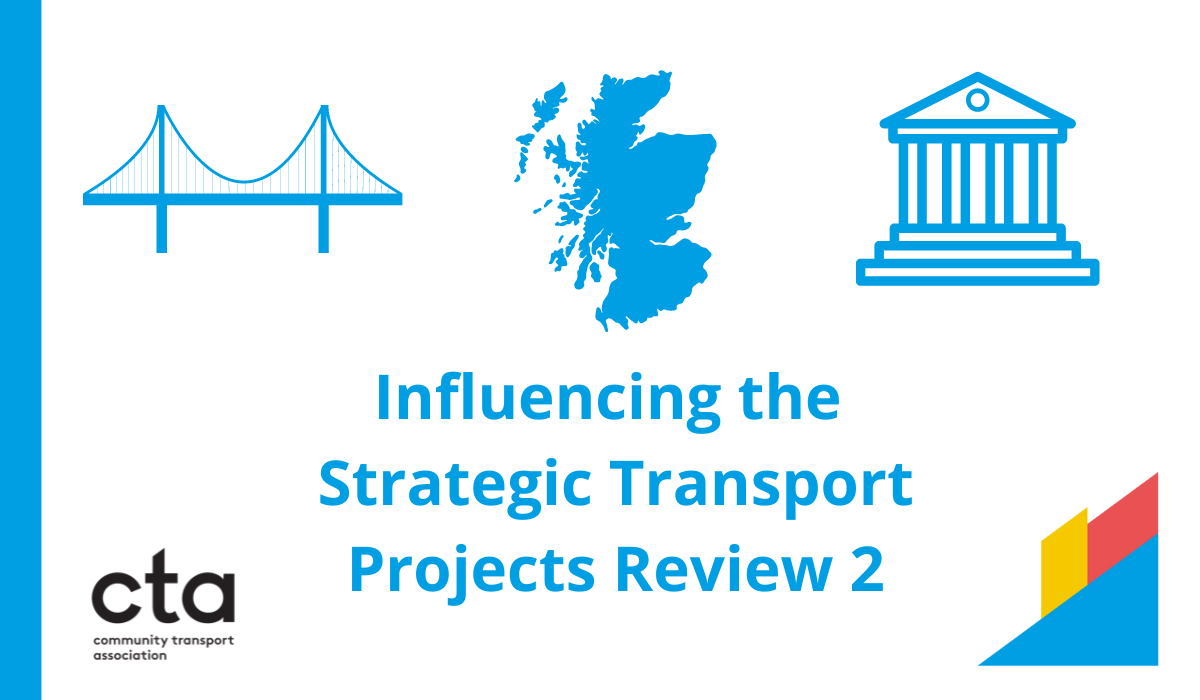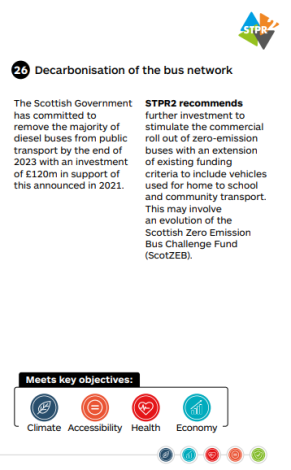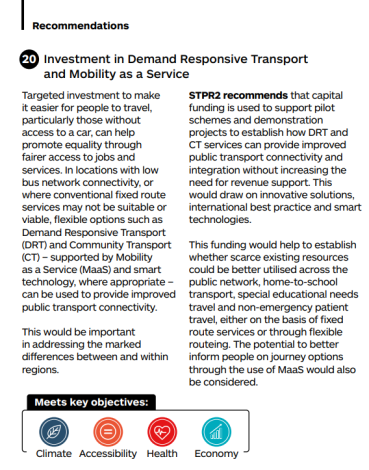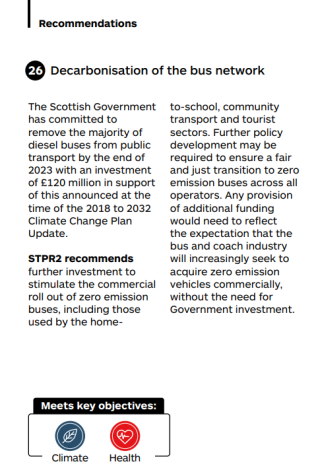-

Influencing Transport Scotland’s STPR2
-
26th January 2023
-
-
by David Kelly
Director for Scotland
Influencing policy takes time. It can be a complex and protracted process with steps forward as well as steps back. Success is far from guaranteed, but persistent, positive engagement and clear, convincing messaging can go a long way.
I see getting this right in our policy and public affairs work as a major part of my role as CTA’s Director for Scotland, the sector’s champion north of the border.
And so it’s proved in the case of Transport Scotland’s Strategic Transport Projects Review 2, which is also known as (and I’m not making this up) the ‘STPR2’.
I know what you’re thinking: ‘that sounds like a lot of jargon’. And you’d be right! But bear with me, because it’s quite important – not just for the Community Transport sector today, but also for the long-term future of Scotland’s whole transport system.
The STPR2 might sound obscure or mysterious (and it certainly isn’t the most accessible publication). Nonetheless, it’s a key document in Scotland’s system of devolved government. According to Transport Scotland, it is ‘a review of the strategic transport network’s performance’ which ‘inform[s] transport investment in Scotland for the next 20 years (2022-2042) by providing evidence-based recommendations on which Scottish Ministers can base future transport investment decisions’.
In other words, the STPR2 is a kind of ‘policy bible’ setting out the Scottish Government’s major transport commitments and priorities for the next two decades. For policy wonks like me, STPR2 is the stuff of dreams (or, perhaps, nightmares…). To paraphrase Joe Biden, Amtrack aficionado and US President, it’s a big deal.
The first Strategic Transport Projects Review (STPR1, anyone?) was published in 2008 and contained a total of ‘29 transport investment priorities’. It made major pledges to deliver exciting and even transformational projects which are now a reality – like the Forth Replacement Crossing (now the Queensferry Crossing) and a big programme of rail electrification along key routes (such as the Edinburgh to Glasgow via Falkirk line and the Stirling/Alloa/Dunblane lines).
But there have also clearly been disappointments and setbacks. STPR1 aimed to reduce carbon emissions ‘to tackle the issues of climate change, air quality and health improvement’ – yet since 2008 Scotland’s transport emissions have hardly changed. In fact, they’ve not been cut since 1990. Transport has become Scotland’s largest emitter during a period in which massive investment in renewables largely decarbonised our energy generation. Much of STPR1 was actually focused on building more and bigger roads which, unsurprisingly, only fuelled private car use.
Likewise, there were commitments to give the Scottish people ‘value for money for an alternative to the car’ with high-quality, affordable public transport, yet the cost of buses and trains has only risen.
Demand responsive transport and community car schemes were briefly cited in the STPR1 back in 2008, but Community Transport wasn’t recognised as a national priority or included in any of the 29 investment priorities.
Over a decade later, the STPR2 was launched, with a long review process kicking off in 2019 and only concluding nearly three years later with publication of the final version in December 2022.
In January 2022, Transport Scotland published a draft STPR2 as part of the final round of consultations, which included a call for written evidence. The draft STPR2 contained 45 major recommendations to Scottish Ministers, including headline grabbing commitments to a Glasgow Metro, as well as some encouraging signs for the Community Transport sector.
Recommendation 20 committed to invest in Demand Responsive Transport (DRT) and Mobility as a Service (MaaS) ‘in locations where conventional fixed route bus services may not be suitable or viable, flexible options’. It recognised this could have particular benefits for non-emergency patient transport. However, it didn’t identify the essential and existing role of Community Transport. We’ve been clear that ‘MaaS for all’ can only be delivered in partnership with our sector, its operators and its drivers.
![]()
Recommendation 26 pledged further investment in the decarbonisation of Scotland’s bus network, including a very welcome ‘extension of existing funding criteria to include vehicles used for home to school and community transport’. However, we believed that this recommendation lacked recognition of the specific financial challenges and vehicular needs of the Community Transport sector, as well as the limited supply of Electric Wheelchair Accessible Vehicles (eWAVs).
![]()


Our response to Transport Scotland’s consultation on the draft STPR2 was submitted in April and raised these important issues. It called for amendments to which would lead to:
- Investment in DRT services by Community Transport operators
- Inclusion of Community Transport services in MaaS pilots and projects
- Greater financial support’ to decarbonise the Community Transport fleet to better match the scale of public investment so far in the commercial bus sector’s transition to net zero
In September, we also published our More Than a Minibus report, which provided new data and evidence on the diversity of our sector and the scale of its ‘net zero funding gap’ to strengthen our case. Data and evidence from our members really does help.
By December, the final STPR2 had been confirmed and was ready for publication. It was clear that Recommendations 20 and 26 had been significantly amended.
The new and improved Recommendation 20 cited the ‘important’ role and potential of Community Transport as an effective means of delivering ‘flexible options’ like DRT and MaaS. It also called for capital funding to ‘support pilot schemes and demonstration projects to establish how DRT and CT services can provide improved public transport connectivity and integration’. A reluctance to countenance ‘increased revenue support’ overall was disappointing, but perhaps unsurprising given the current fiscal climate.
![]()


As well as reiterating the need for funding for Community Transport to purchase Electric Vehicles to be scaled-up, the updated Recommendation 26 noted that ‘further policy development may be required to ensure a fair and just transition to zero emission buses across all operators’. The focus is now not just on commercial bus services, but on non-profit operators too.
![]()


All in all, these changes were highly significant and very heartening. Our representations have been listened to and have resulted in meaningful amendments to the text of the STPR2. My hope is that this will shape Transport Scotland’s policies and the Scottish Government’s investment for many years to come, benefiting generations of Community Transport operators, staff, volunteers and passengers.
Influencing policy takes time. It can be a complex and protracted process with steps forward as well as steps back. Success is far from guaranteed – but this one was definitely, as Biden would say, a big deal!
-
-
- About CTA
- /
- CTA Membership
- /
- CTWeek24
- /
- Policy & Research
- CommunitySolutions: A Manifesto for the Next UK General Election
- Our Campaigning Guide for Community Transport
- Our Policy Work
- Join Our Mapping England Passenger Survey
- Aneurin Bevan Transport to Health
- Climate Action in Scotland
- conneCTing England Programme
- Mapping Scotland Project
- Mapping Wales
- Mapping England
- Tackling Loneliness in England
- Healthy Communities in Scotland
- /
- Advice & Support
- /
- Training
- /
- Events
- /




